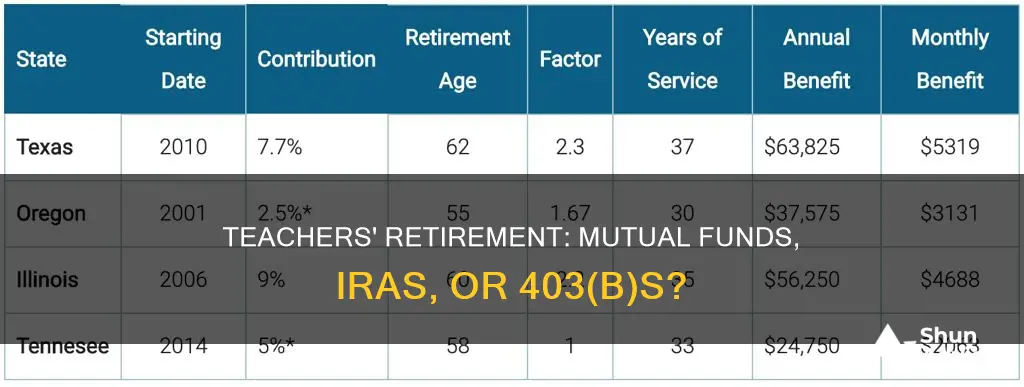
Teachers often face a difficult decision when it comes to planning for their retirement. With options like traditional mutual funds, IRAs, or 403(b)s, it can be challenging to determine which investment vehicle is the best fit. Each option has its own set of advantages and disadvantages, and the right choice depends on various factors, including tax implications, investment goals, risk tolerance, and future tax laws. Understanding the key differences between these options is essential for teachers to make informed decisions about their financial future.
| Characteristics | Values |
|---|---|
| Tax benefits | Current tax savings |
| Future tax savings | |
| Tax-free retirement income | |
| Investment options | Individual stocks |
| Mutual funds | |
| Exchange-traded funds (ETFs) | |
| Robo-advisors | |
| Target-date funds | |
| Low-cost index funds | |
| Low-cost robo-advisors | |
| Low-cost target-date funds | |
| Variable annuities | |
| Fixed annuities | |
| Indexed annuities |
What You'll Learn

Weigh up the tax benefits of 403(b)s vs IRAs
When weighing up the tax benefits of 403(b)s and IRAs, it's important to consider the differences between the two. Both are retirement accounts that offer tax benefits, but there are some key distinctions to keep in mind.
With a 403(b) plan, contributions are made pre-tax, lowering your taxable income for the year. This means you will pay tax on distributions when you withdraw the money, typically during retirement. Growth in plan assets is also tax-deferred, so all dividends, interest, and capital gains are accumulated tax-free until withdrawal. It's important to note that 403(b) plans have maximum contribution limits that are adjusted annually for cost-of-living increases.
On the other hand, IRAs offer more flexibility in terms of investment options and can be opened by anyone with taxable compensation. There are two main types of IRAs: traditional and Roth. With a traditional IRA, you may be able to deduct your contributions from income taxes, and any growth in the account is taxable upon withdrawal. Roth IRAs, on the other hand, do not offer tax deductions, but contributions are made with after-tax dollars, and withdrawals are tax-free in retirement. It's worth noting that there are income limits for contributing to a Roth IRA, and there are no such limits for a 403(b).
When deciding between a 403(b) and an IRA, it's important to consider your current tax situation and your expected tax rate in retirement. If you are currently in a higher tax bracket than you anticipate being in during retirement, a 403(b) may be more advantageous due to the immediate tax savings. However, if you expect your tax rate to be higher in retirement, a Roth IRA may be a better option as it allows tax-free withdrawals. Additionally, it's worth considering the state income tax in your current state versus the state you plan to retire in, as this could impact the tax benefits of each option.
In conclusion, both 403(b)s and IRAs offer tax benefits, but the optimal choice depends on your individual circumstances and tax situation. It may be beneficial to consult with a financial advisor to determine the best option for your specific needs and goals.
Real Estate Funds vs. Buying a House: What's the Difference?
You may want to see also

Understand the risks of annuities
Annuities are generally considered safe investments, offering a guaranteed income—often for life—and providing security in retirement. However, it's important to understand the risks associated with annuities before investing. Here are some key points to consider:
Risk of Early Death
Annuities carry the risk of early death, which could result in a loss of income for heirs. However, certain riders can protect beneficiaries from income loss if the annuitant passes away prematurely.
Market Risk
While annuities are not directly exposed to market risk like stocks or bonds, the value of an annuity can be affected by inflation. Over time, inflation can erode the purchasing power of annuity payments, reducing their real value. To mitigate this risk, consider annuities that offer inflation protection or purchase an inflation protection rider.
Tax Implications
The tax implications of annuities can be complex. Annuity income is typically taxed as ordinary income, which has higher tax rates than long-term capital gains. Additionally, annuities do not receive a step-up in cost basis when left to heirs, which can result in a higher tax burden for beneficiaries.
Fees and Charges
Annuities often come with various fees and charges that can impact their overall returns. These include mortality and expense fees, contract maintenance charges, surrender charges, and fees for optional features such as inflation protection or lifetime income riders. It's important to carefully review and compare the fee structures of different annuities before investing.
Type of Annuity
Different types of annuities carry varying levels of risk. Variable annuities, for example, allocate your money into an investment portfolio, potentially exposing you to more volatility and the risk of losing your principal. On the other hand, fixed annuities offer a set level of growth and are considered safer.
Company Stability
The guarantees provided by annuities depend on the financial stability of the issuing insurance company. It's important to assess the insurer's financial strength ratings before purchasing an annuity. In the rare event that the issuing company fails, state guaranty associations typically offer coverage to help recoup losses.
Triton Funds: A Guide to Investing Wisely
You may want to see also

Learn about asset allocation
Asset allocation is an important consideration when deciding how to invest for retirement.
Firstly, it's important to understand the difference between a 403(b) and an IRA. A 403(b) is a retirement account for employees of public schools and tax-exempt organisations, while an IRA is a tax-advantaged investment account that anyone with taxable compensation can open and contribute to. The main difference between the two is that a 403(b) is employer-sponsored, while an IRA is set up by an individual.
Both types of accounts offer tax benefits, but these benefits differ. With a 403(b), you receive a tax deduction for contributions, reducing your current income tax bill. However, withdrawals are taxable when you retire. On the other hand, Roth IRA contributions are made with after-tax dollars, so withdrawals are not subject to income taxes in retirement. Traditional IRAs, meanwhile, offer tax-deductible contributions, but withdrawals are taxable.
When deciding how to allocate your assets, it's important to consider the level of investment choice offered by each type of account. 403(b) plans tend to have more limited investment options compared to IRAs, particularly when compared to a Roth IRA, which offers a high degree of investment flexibility.
Another factor to consider is the impact of future tax laws on your retirement savings. As future tax laws are unpredictable, it may be best to take a diversified approach to your tax planning, in the same way that you would diversify your investments. This could mean contributing to both a 403(b) and a Roth IRA, to take advantage of the benefits of each.
Finally, it's worth noting that you can roll over a 403(b) into an IRA if you are no longer employed by the company that established the account. This can be a way to gain more investment options and consolidate your retirement accounts, making them easier to manage.
International Funds: Diversify Your Portfolio, Gain Global Exposure
You may want to see also

Consider mutual funds
When it comes to retirement planning, there are a number of options to consider, each with its own advantages and considerations. One popular option is to invest in mutual funds, which can be a great way to diversify your portfolio and manage risk. Here are some reasons why mutual funds may be worth considering as part of your retirement plan:
Diversification and Risk Management
Mutual funds are a type of investment fund that pools money from multiple investors to purchase a diversified portfolio of stocks, bonds, or other securities. By investing in mutual funds, you can gain exposure to a wide range of assets, reducing the risk associated with individual stocks or bonds. This diversification helps to spread risk and mitigate the impact of poor-performing investments. The diversification offered by mutual funds can be particularly attractive for teachers who want to take a conservative approach to their retirement savings.
Professional Management
Mutual funds are managed by professional portfolio managers or investment teams who make investment decisions on behalf of the investors. These experts conduct in-depth research and analysis to inform their choices, leveraging their experience and knowledge of the financial markets. This can be especially beneficial for teachers who may not have the time or expertise to actively manage their investments.
Suitability for Various Risk Tolerances and Investment Objectives
Mutual funds cater to investors with different risk tolerances and investment objectives. Whether you are a conservative or aggressive investor, there are mutual funds aligned with your risk profile. Additionally, mutual funds offer a convenient way to access professional money management services, making them suitable for a wide range of investors.
Tax Considerations
When considering mutual funds, it's important to understand the tax implications. Mutual funds may generate capital gains, which are distributed to investors and can result in taxable events. However, the tax treatment of mutual funds can vary depending on the type of IRA you hold (Roth or traditional) and your specific financial situation. It's always advisable to consult with a tax professional to understand the tax consequences of your investment choices.
Accessibility and Investment Minimums
Mutual funds typically have minimum investment requirements, which may be a barrier for investors with limited capital. However, they are widely accessible through various financial institutions, including banks, brokerage firms, and mutual fund companies. It's essential to research and compare the minimum investment amounts and fees associated with different mutual fund offerings.
In conclusion, mutual funds offer a range of benefits, including diversification, professional management, and accessibility. When deciding whether to invest in mutual funds as a teacher, it's important to carefully consider your financial goals, risk tolerance, and tax situation. Consulting with a financial advisor can help you make informed decisions about your retirement planning strategy.
Maximizing Your HSA: To Invest or Not to Invest?
You may want to see also

Compare traditional and Roth IRAs
When deciding between a traditional and a Roth IRA, the primary difference to consider is how and when your money is taxed.
With a traditional IRA, you can make tax-deductible contributions, meaning your taxable income for the year of contribution is reduced. However, withdrawals in retirement are taxed as income. There are also required minimum distributions (RMDs) with a traditional IRA, meaning you must withdraw a minimum amount of money starting at a certain age.
On the other hand, contributions to a Roth IRA are made with after-tax dollars, so there is no immediate tax benefit. However, withdrawals in retirement, including earnings, are generally tax-free. Additionally, there are no RMDs with a Roth IRA, giving you more flexibility in managing your tax burden in retirement.
Another difference lies in the eligibility requirements. Traditional IRAs have no income restrictions, but the tax-deductibility of contributions may be phased out depending on income and access to an employer retirement plan. In contrast, Roth IRAs have income eligibility restrictions, with contribution limits based on modified adjusted gross income (MAGI).
When deciding between a traditional and Roth IRA, a key consideration is your expected future income and tax bracket in retirement. If you anticipate being in a higher tax bracket during retirement, a Roth IRA may be preferable to take advantage of tax-free withdrawals. On the other hand, if you expect to be in a lower tax bracket, a traditional IRA may be more advantageous to benefit from the upfront tax deduction.
It's worth noting that you can contribute to both a traditional and a Roth IRA simultaneously, as long as the total contributions do not exceed the annual limit.
Investing in Mutual Funds: A Wise Move at 63?
You may want to see also
Frequently asked questions
The primary difference between traditional and Roth IRAs is how and when your money is taxed. With a traditional IRA, you can make tax-deductible contributions, but the withdrawals are taxable. On the other hand, Roth IRA contributions are not tax-deductible, but the withdrawals are tax-free.
Mutual funds offer a convenient way to achieve diversification and access professional management, making them suitable for investors with different risk tolerances and investment objectives. They collect money from multiple investors and invest in a diversified portfolio of stocks, bonds, or other securities.
The choice depends on your investment goals, risk tolerance, and beliefs. Actively managed funds have fund managers making investment decisions, while passively managed funds track specific benchmarks.
There are a few factors to consider when deciding between a 403(b) and an IRA. Firstly, understand the tax implications of each option. While a 403(b) provides tax benefits now, a Roth IRA offers tax-free withdrawals in retirement. Additionally, consider your future tax situation and whether you plan to retire in a state with different tax laws. Diversification is also important, just like with your investments; having various retirement plans can provide a more secure retirement.







